BTEC Level 5 Business Environment Report: Organization Analysis
VerifiedAdded on 2021/08/28
|19
|6847
|112
Report
AI Summary
This student assignment is a comprehensive report focusing on business environments, organizational structures, and functions. The report begins by defining and explaining the purpose of public, private, and voluntary organizations, along with their legal structures and sizes. It then introduces a chosen organization, providing details on its background, products, services, size, scope, vision, mission, business objectives, organizational and legal structure, stakeholders, and competitors. The analysis section includes the organization's structure chart, explaining the relationship between its functions and objectives. The report analyzes the advantages and disadvantages of interrelationships between different organizational functions and their impact on the organization's structure. It compares and contrasts the chosen organization with a government/public/voluntary company. The report also conducts a macro environmental analysis using the PESTLE model and a micro environmental analysis using the SWOT model. The report concludes with a critical evaluation, explaining how the outcomes of the PESTLE and SWOT analyses interrelate and influence business objectives and decision-making, and provides recommendations for improvements in light of EXPO 2020.
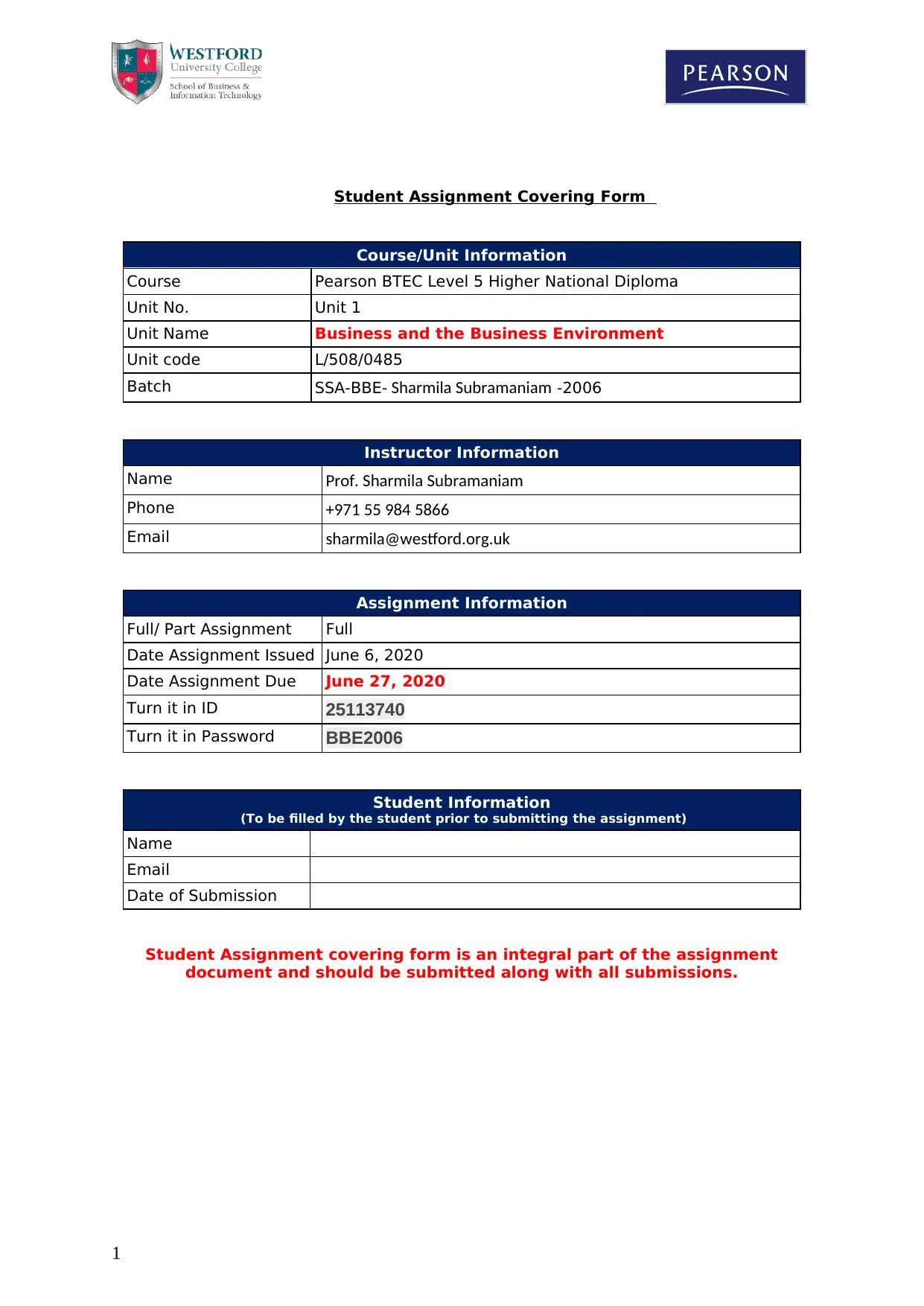
Student Assignment Covering Form
Course/Unit Information
Course Pearson BTEC Level 5 Higher National Diploma
Unit No. Unit 1
Unit Name Business and the Business Environment
Unit code L/508/0485
Batch SSA-BBE- Sharmila Subramaniam -2006
Instructor Information
Name Prof. Sharmila Subramaniam
Phone +971 55 984 5866
Email sharmila@westford.org.uk
Assignment Information
Full/ Part Assignment Full
Date Assignment Issued June 6, 2020
Date Assignment Due June 27, 2020
Turn it in ID 25113740
Turn it in Password BBE2006
Student Information
(To be filled by the student prior to submitting the assignment)
Name
Email
Date of Submission
Student Assignment covering form is an integral part of the assignment
document and should be submitted along with all submissions.
1
Course/Unit Information
Course Pearson BTEC Level 5 Higher National Diploma
Unit No. Unit 1
Unit Name Business and the Business Environment
Unit code L/508/0485
Batch SSA-BBE- Sharmila Subramaniam -2006
Instructor Information
Name Prof. Sharmila Subramaniam
Phone +971 55 984 5866
Email sharmila@westford.org.uk
Assignment Information
Full/ Part Assignment Full
Date Assignment Issued June 6, 2020
Date Assignment Due June 27, 2020
Turn it in ID 25113740
Turn it in Password BBE2006
Student Information
(To be filled by the student prior to submitting the assignment)
Name
Date of Submission
Student Assignment covering form is an integral part of the assignment
document and should be submitted along with all submissions.
1
Paraphrase This Document
Need a fresh take? Get an instant paraphrase of this document with our AI Paraphraser
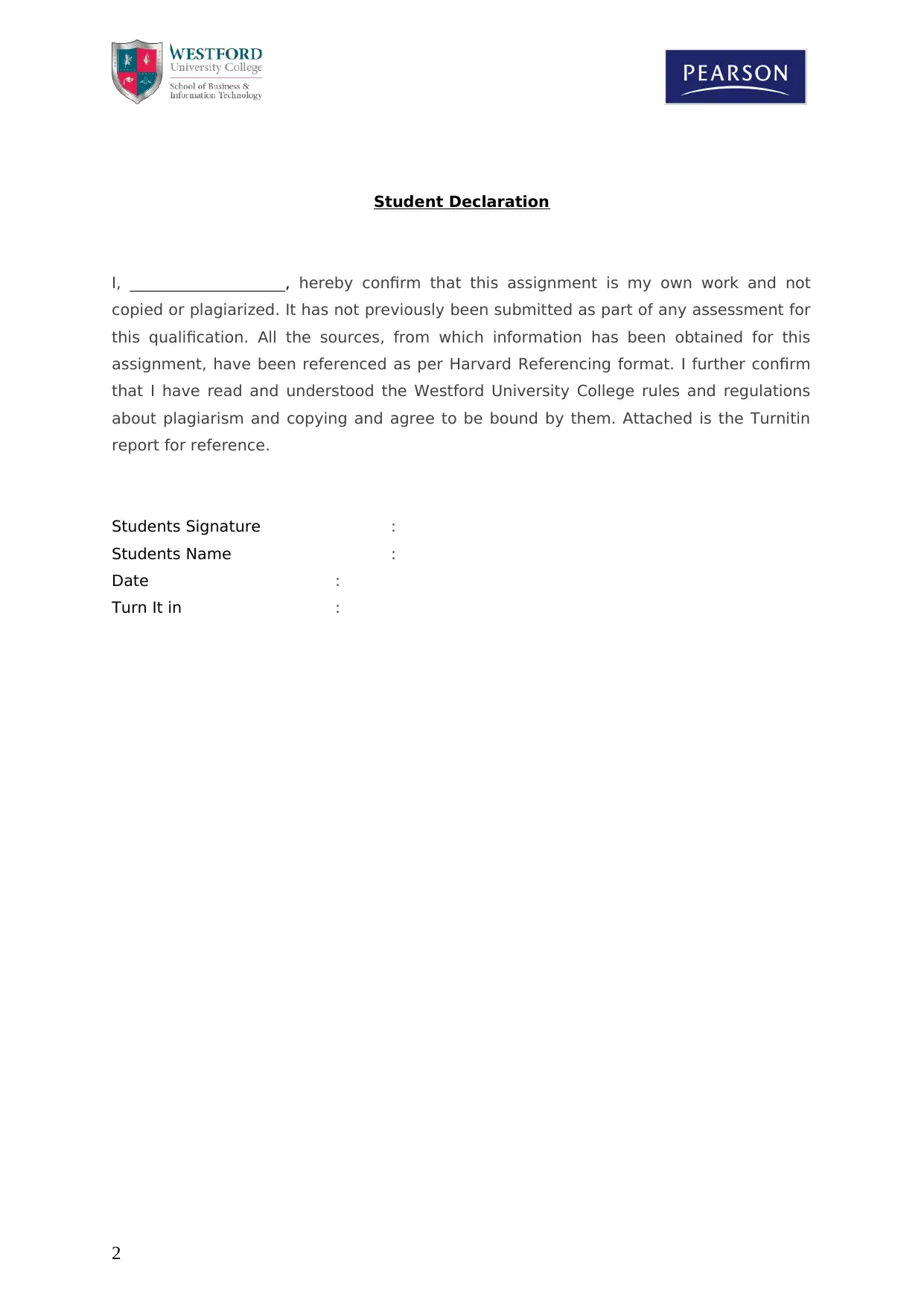
Student Declaration
I, ____________________, hereby confirm that this assignment is my own work and not
copied or plagiarized. It has not previously been submitted as part of any assessment for
this qualification. All the sources, from which information has been obtained for this
assignment, have been referenced as per Harvard Referencing format. I further confirm
that I have read and understood the Westford University College rules and regulations
about plagiarism and copying and agree to be bound by them. Attached is the Turnitin
report for reference.
Students Signature :
Students Name :
Date :
Turn It in :
2
I, ____________________, hereby confirm that this assignment is my own work and not
copied or plagiarized. It has not previously been submitted as part of any assessment for
this qualification. All the sources, from which information has been obtained for this
assignment, have been referenced as per Harvard Referencing format. I further confirm
that I have read and understood the Westford University College rules and regulations
about plagiarism and copying and agree to be bound by them. Attached is the Turnitin
report for reference.
Students Signature :
Students Name :
Date :
Turn It in :
2
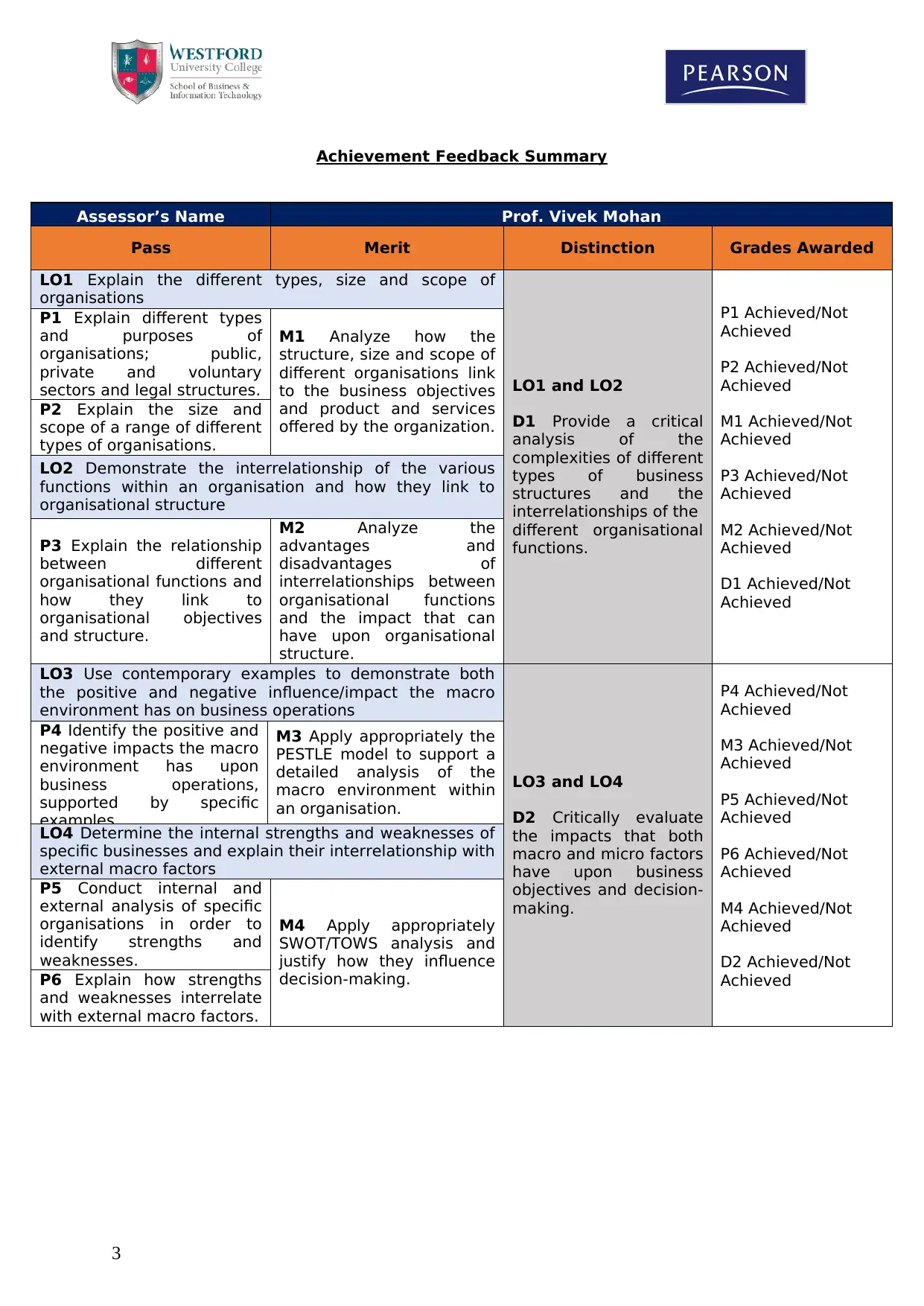
Achievement Feedback Summary
Assessor’s Name Prof. Vivek Mohan
Pass Merit Distinction Grades Awarded
LO1 Explain the different types, size and scope of
organisations
LO1 and LO2
D1 Provide a critical
analysis of the
complexities of different
types of business
structures and the
interrelationships of the
different organisational
functions.
P1 Achieved/Not
Achieved
P2 Achieved/Not
Achieved
M1 Achieved/Not
Achieved
P3 Achieved/Not
Achieved
M2 Achieved/Not
Achieved
D1 Achieved/Not
Achieved
P1 Explain different types
and purposes of
organisations; public,
private and voluntary
sectors and legal structures.
M1 Analyze how the
structure, size and scope of
different organisations link
to the business objectives
and product and services
offered by the organization.
P2 Explain the size and
scope of a range of different
types of organisations.
LO2 Demonstrate the interrelationship of the various
functions within an organisation and how they link to
organisational structure
P3 Explain the relationship
between different
organisational functions and
how they link to
organisational objectives
and structure.
M2 Analyze the
advantages and
disadvantages of
interrelationships between
organisational functions
and the impact that can
have upon organisational
structure.
LO3 Use contemporary examples to demonstrate both
the positive and negative influence/impact the macro
environment has on business operations
LO3 and LO4
D2 Critically evaluate
the impacts that both
macro and micro factors
have upon business
objectives and decision-
making.
P4 Achieved/Not
Achieved
M3 Achieved/Not
Achieved
P5 Achieved/Not
Achieved
P6 Achieved/Not
Achieved
M4 Achieved/Not
Achieved
D2 Achieved/Not
Achieved
P4 Identify the positive and
negative impacts the macro
environment has upon
business operations,
supported by specific
examples.
M3 Apply appropriately the
PESTLE model to support a
detailed analysis of the
macro environment within
an organisation.
LO4 Determine the internal strengths and weaknesses of
specific businesses and explain their interrelationship with
external macro factors
P5 Conduct internal and
external analysis of specific
organisations in order to
identify strengths and
weaknesses.
M4 Apply appropriately
SWOT/TOWS analysis and
justify how they influence
decision-making.P6 Explain how strengths
and weaknesses interrelate
with external macro factors.
3
Assessor’s Name Prof. Vivek Mohan
Pass Merit Distinction Grades Awarded
LO1 Explain the different types, size and scope of
organisations
LO1 and LO2
D1 Provide a critical
analysis of the
complexities of different
types of business
structures and the
interrelationships of the
different organisational
functions.
P1 Achieved/Not
Achieved
P2 Achieved/Not
Achieved
M1 Achieved/Not
Achieved
P3 Achieved/Not
Achieved
M2 Achieved/Not
Achieved
D1 Achieved/Not
Achieved
P1 Explain different types
and purposes of
organisations; public,
private and voluntary
sectors and legal structures.
M1 Analyze how the
structure, size and scope of
different organisations link
to the business objectives
and product and services
offered by the organization.
P2 Explain the size and
scope of a range of different
types of organisations.
LO2 Demonstrate the interrelationship of the various
functions within an organisation and how they link to
organisational structure
P3 Explain the relationship
between different
organisational functions and
how they link to
organisational objectives
and structure.
M2 Analyze the
advantages and
disadvantages of
interrelationships between
organisational functions
and the impact that can
have upon organisational
structure.
LO3 Use contemporary examples to demonstrate both
the positive and negative influence/impact the macro
environment has on business operations
LO3 and LO4
D2 Critically evaluate
the impacts that both
macro and micro factors
have upon business
objectives and decision-
making.
P4 Achieved/Not
Achieved
M3 Achieved/Not
Achieved
P5 Achieved/Not
Achieved
P6 Achieved/Not
Achieved
M4 Achieved/Not
Achieved
D2 Achieved/Not
Achieved
P4 Identify the positive and
negative impacts the macro
environment has upon
business operations,
supported by specific
examples.
M3 Apply appropriately the
PESTLE model to support a
detailed analysis of the
macro environment within
an organisation.
LO4 Determine the internal strengths and weaknesses of
specific businesses and explain their interrelationship with
external macro factors
P5 Conduct internal and
external analysis of specific
organisations in order to
identify strengths and
weaknesses.
M4 Apply appropriately
SWOT/TOWS analysis and
justify how they influence
decision-making.P6 Explain how strengths
and weaknesses interrelate
with external macro factors.
3
⊘ This is a preview!⊘
Do you want full access?
Subscribe today to unlock all pages.

Trusted by 1+ million students worldwide
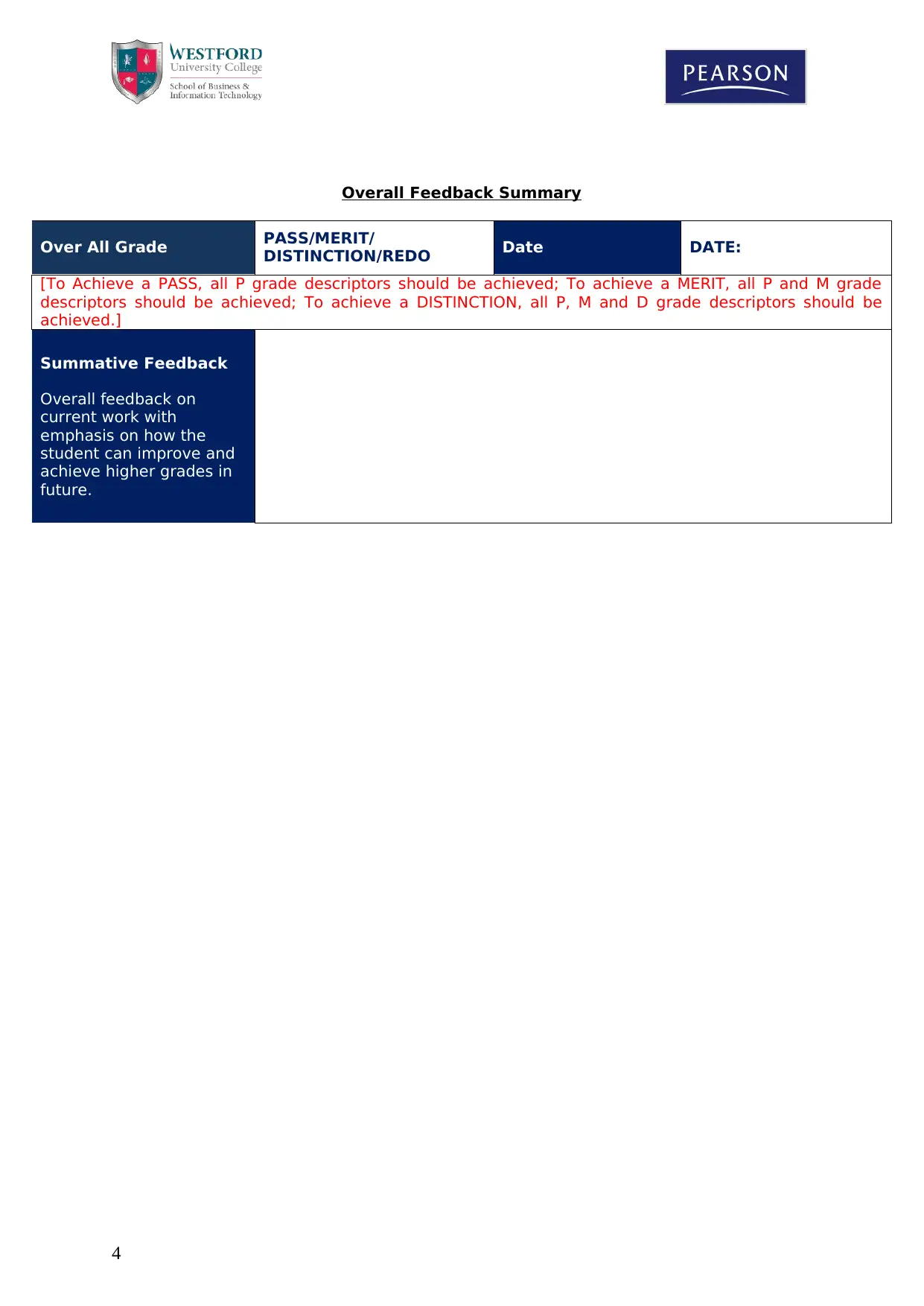
Overall Feedback Summary
Over All Grade PASS/MERIT/
DISTINCTION/REDO Date DATE:
[To Achieve a PASS, all P grade descriptors should be achieved; To achieve a MERIT, all P and M grade
descriptors should be achieved; To achieve a DISTINCTION, all P, M and D grade descriptors should be
achieved.]
Summative Feedback
Overall feedback on
current work with
emphasis on how the
student can improve and
achieve higher grades in
future.
4
Over All Grade PASS/MERIT/
DISTINCTION/REDO Date DATE:
[To Achieve a PASS, all P grade descriptors should be achieved; To achieve a MERIT, all P and M grade
descriptors should be achieved; To achieve a DISTINCTION, all P, M and D grade descriptors should be
achieved.]
Summative Feedback
Overall feedback on
current work with
emphasis on how the
student can improve and
achieve higher grades in
future.
4
Paraphrase This Document
Need a fresh take? Get an instant paraphrase of this document with our AI Paraphraser
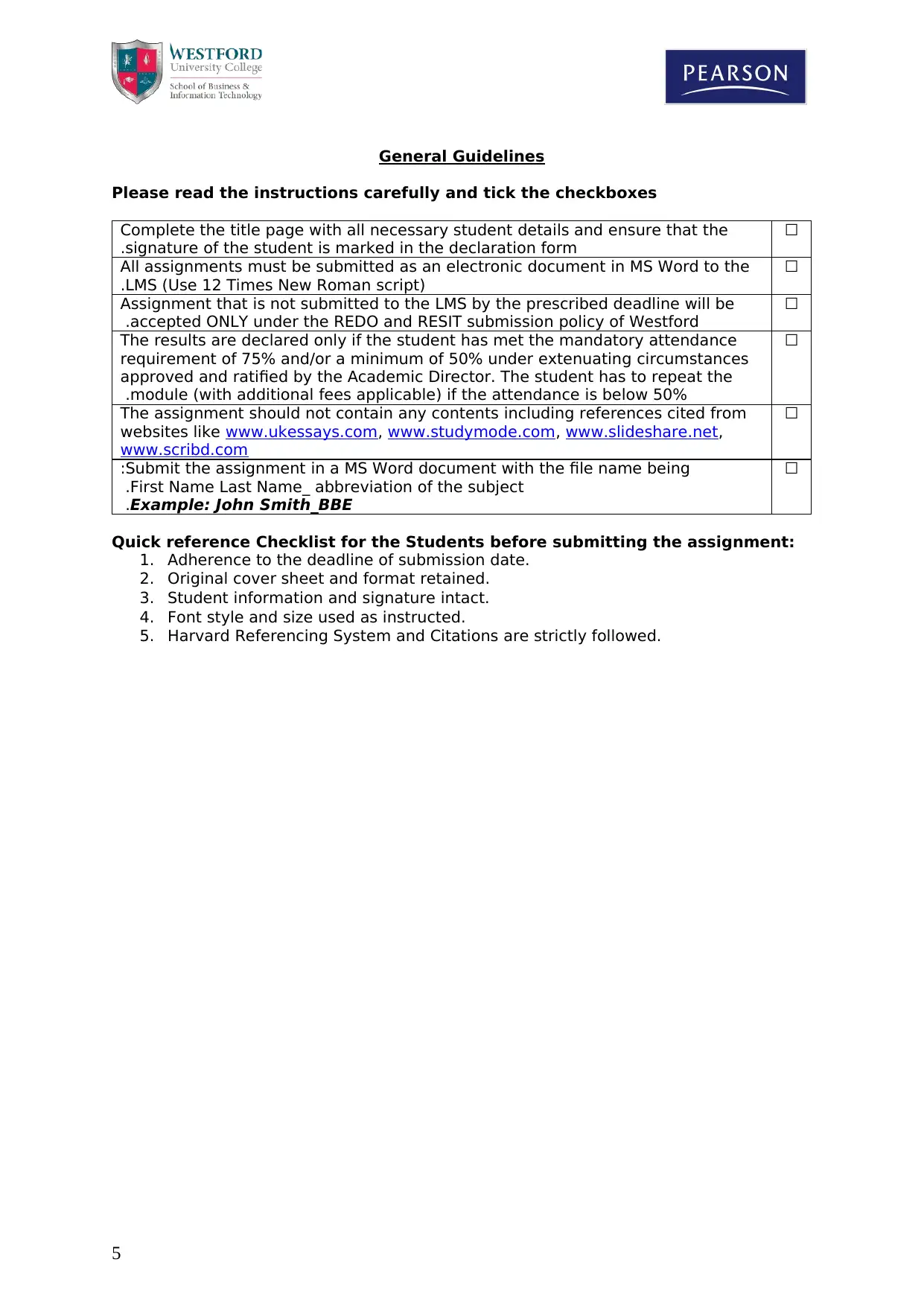
General Guidelines
Please read the instructions carefully and tick the checkboxes
☐Complete the title page with all necessary student details and ensure that the
signature of the student is marked in the declaration form.
☐All assignments must be submitted as an electronic document in MS Word to the
LMS (Use 12 Times New Roman script).
☐Assignment that is not submitted to the LMS by the prescribed deadline will be
accepted ONLY under the REDO and RESIT submission policy of Westford.
☐The results are declared only if the student has met the mandatory attendance
requirement of 75% and/or a minimum of 50% under extenuating circumstances
approved and ratified by the Academic Director. The student has to repeat the
module (with additional fees applicable) if the attendance is below 50%.
☐The assignment should not contain any contents including references cited from
websites like www.ukessays.com, www.studymode.com, www.slideshare.net,
www.scribd.com
☐Submit the assignment in a MS Word document with the file name being:
First Name Last Name_ abbreviation of the subject.
Example: John Smith_BBE.
Quick reference Checklist for the Students before submitting the assignment:
1. Adherence to the deadline of submission date.
2. Original cover sheet and format retained.
3. Student information and signature intact.
4. Font style and size used as instructed.
5. Harvard Referencing System and Citations are strictly followed.
5
Please read the instructions carefully and tick the checkboxes
☐Complete the title page with all necessary student details and ensure that the
signature of the student is marked in the declaration form.
☐All assignments must be submitted as an electronic document in MS Word to the
LMS (Use 12 Times New Roman script).
☐Assignment that is not submitted to the LMS by the prescribed deadline will be
accepted ONLY under the REDO and RESIT submission policy of Westford.
☐The results are declared only if the student has met the mandatory attendance
requirement of 75% and/or a minimum of 50% under extenuating circumstances
approved and ratified by the Academic Director. The student has to repeat the
module (with additional fees applicable) if the attendance is below 50%.
☐The assignment should not contain any contents including references cited from
websites like www.ukessays.com, www.studymode.com, www.slideshare.net,
www.scribd.com
☐Submit the assignment in a MS Word document with the file name being:
First Name Last Name_ abbreviation of the subject.
Example: John Smith_BBE.
Quick reference Checklist for the Students before submitting the assignment:
1. Adherence to the deadline of submission date.
2. Original cover sheet and format retained.
3. Student information and signature intact.
4. Font style and size used as instructed.
5. Harvard Referencing System and Citations are strictly followed.
5
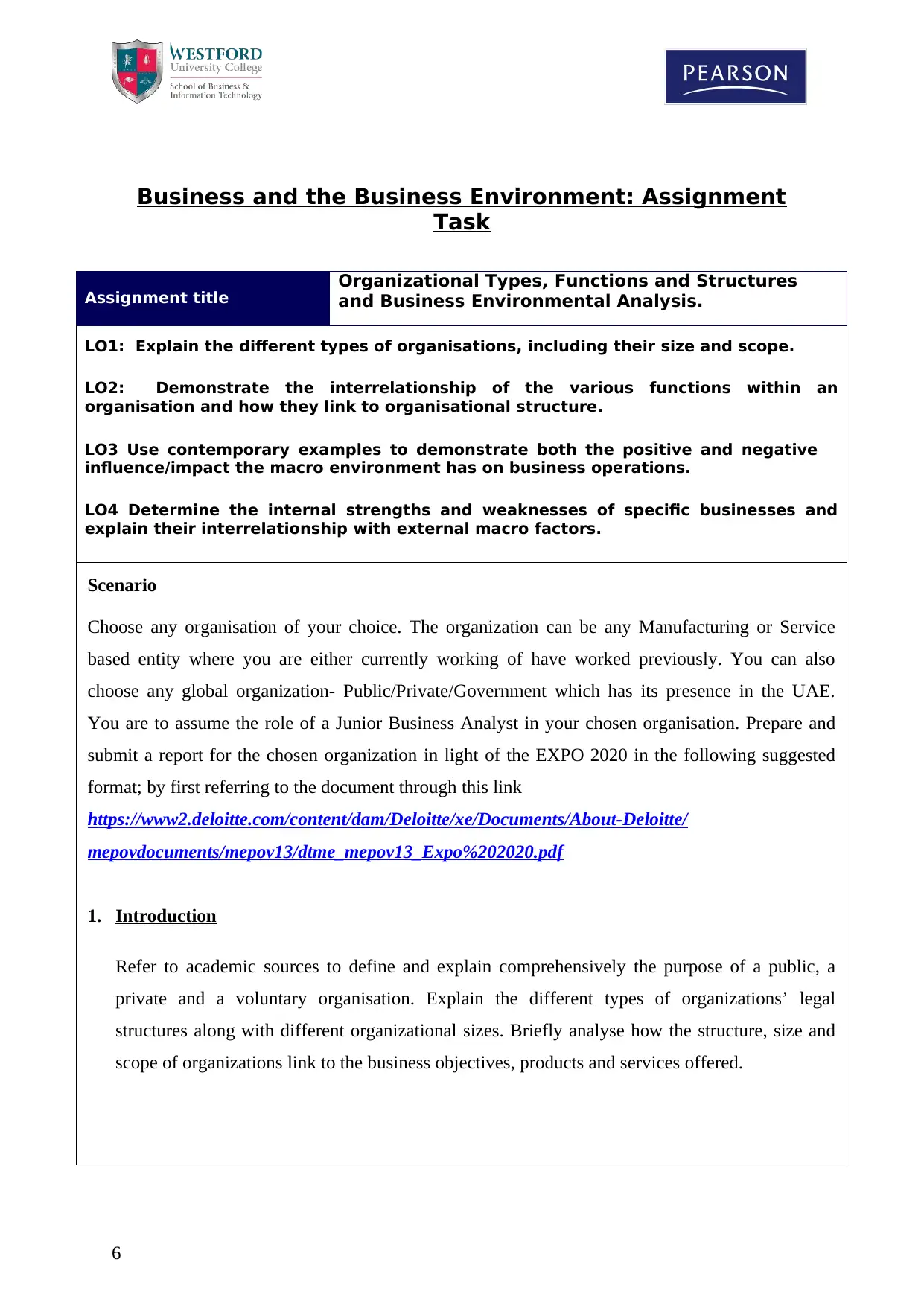
Business and the Business Environment: Assignment
Task
Assignment title
Organizational Types, Functions and Structures
and Business Environmental Analysis.
LO1: Explain the different types of organisations, including their size and scope.
LO2: Demonstrate the interrelationship of the various functions within an
organisation and how they link to organisational structure.
LO3 Use contemporary examples to demonstrate both the positive and negative
influence/impact the macro environment has on business operations.
LO4 Determine the internal strengths and weaknesses of specific businesses and
explain their interrelationship with external macro factors.
Scenario
Choose any organisation of your choice. The organization can be any Manufacturing or Service
based entity where you are either currently working of have worked previously. You can also
choose any global organization- Public/Private/Government which has its presence in the UAE.
You are to assume the role of a Junior Business Analyst in your chosen organisation. Prepare and
submit a report for the chosen organization in light of the EXPO 2020 in the following suggested
format; by first referring to the document through this link
https://www2.deloitte.com/content/dam/Deloitte/xe/Documents/About-Deloitte/
mepovdocuments/mepov13/dtme_mepov13_Expo%202020.pdf
1. Introduction
Refer to academic sources to define and explain comprehensively the purpose of a public, a
private and a voluntary organisation. Explain the different types of organizations’ legal
structures along with different organizational sizes. Briefly analyse how the structure, size and
scope of organizations link to the business objectives, products and services offered.
6
Task
Assignment title
Organizational Types, Functions and Structures
and Business Environmental Analysis.
LO1: Explain the different types of organisations, including their size and scope.
LO2: Demonstrate the interrelationship of the various functions within an
organisation and how they link to organisational structure.
LO3 Use contemporary examples to demonstrate both the positive and negative
influence/impact the macro environment has on business operations.
LO4 Determine the internal strengths and weaknesses of specific businesses and
explain their interrelationship with external macro factors.
Scenario
Choose any organisation of your choice. The organization can be any Manufacturing or Service
based entity where you are either currently working of have worked previously. You can also
choose any global organization- Public/Private/Government which has its presence in the UAE.
You are to assume the role of a Junior Business Analyst in your chosen organisation. Prepare and
submit a report for the chosen organization in light of the EXPO 2020 in the following suggested
format; by first referring to the document through this link
https://www2.deloitte.com/content/dam/Deloitte/xe/Documents/About-Deloitte/
mepovdocuments/mepov13/dtme_mepov13_Expo%202020.pdf
1. Introduction
Refer to academic sources to define and explain comprehensively the purpose of a public, a
private and a voluntary organisation. Explain the different types of organizations’ legal
structures along with different organizational sizes. Briefly analyse how the structure, size and
scope of organizations link to the business objectives, products and services offered.
6
⊘ This is a preview!⊘
Do you want full access?
Subscribe today to unlock all pages.

Trusted by 1+ million students worldwide
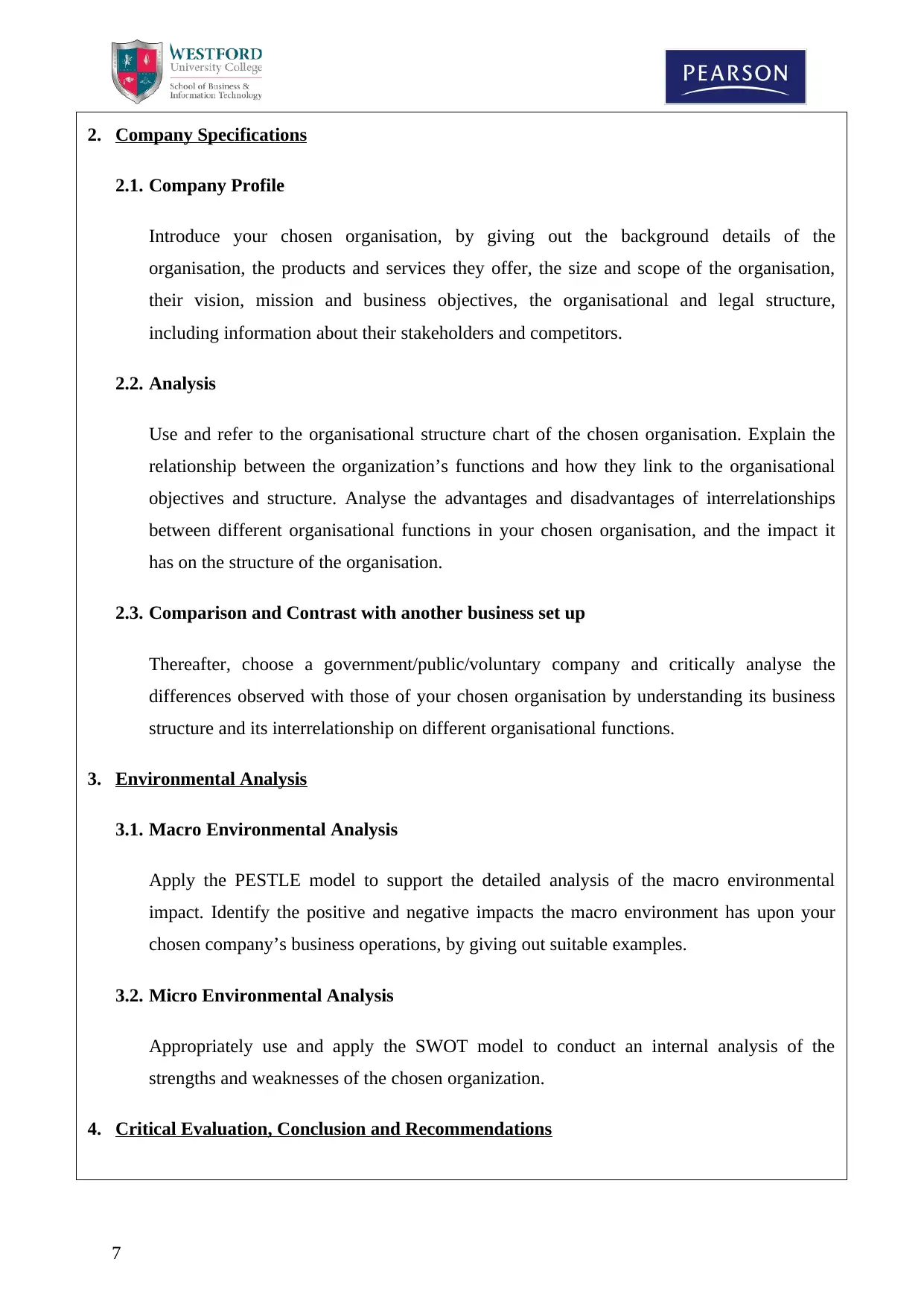
2. Company Specifications
2.1. Company Profile
Introduce your chosen organisation, by giving out the background details of the
organisation, the products and services they offer, the size and scope of the organisation,
their vision, mission and business objectives, the organisational and legal structure,
including information about their stakeholders and competitors.
2.2. Analysis
Use and refer to the organisational structure chart of the chosen organisation. Explain the
relationship between the organization’s functions and how they link to the organisational
objectives and structure. Analyse the advantages and disadvantages of interrelationships
between different organisational functions in your chosen organisation, and the impact it
has on the structure of the organisation.
2.3. Comparison and Contrast with another business set up
Thereafter, choose a government/public/voluntary company and critically analyse the
differences observed with those of your chosen organisation by understanding its business
structure and its interrelationship on different organisational functions.
3. Environmental Analysis
3.1. Macro Environmental Analysis
Apply the PESTLE model to support the detailed analysis of the macro environmental
impact. Identify the positive and negative impacts the macro environment has upon your
chosen company’s business operations, by giving out suitable examples.
3.2. Micro Environmental Analysis
Appropriately use and apply the SWOT model to conduct an internal analysis of the
strengths and weaknesses of the chosen organization.
4. Critical Evaluation, Conclusion and Recommendations
7
2.1. Company Profile
Introduce your chosen organisation, by giving out the background details of the
organisation, the products and services they offer, the size and scope of the organisation,
their vision, mission and business objectives, the organisational and legal structure,
including information about their stakeholders and competitors.
2.2. Analysis
Use and refer to the organisational structure chart of the chosen organisation. Explain the
relationship between the organization’s functions and how they link to the organisational
objectives and structure. Analyse the advantages and disadvantages of interrelationships
between different organisational functions in your chosen organisation, and the impact it
has on the structure of the organisation.
2.3. Comparison and Contrast with another business set up
Thereafter, choose a government/public/voluntary company and critically analyse the
differences observed with those of your chosen organisation by understanding its business
structure and its interrelationship on different organisational functions.
3. Environmental Analysis
3.1. Macro Environmental Analysis
Apply the PESTLE model to support the detailed analysis of the macro environmental
impact. Identify the positive and negative impacts the macro environment has upon your
chosen company’s business operations, by giving out suitable examples.
3.2. Micro Environmental Analysis
Appropriately use and apply the SWOT model to conduct an internal analysis of the
strengths and weaknesses of the chosen organization.
4. Critical Evaluation, Conclusion and Recommendations
7
Paraphrase This Document
Need a fresh take? Get an instant paraphrase of this document with our AI Paraphraser
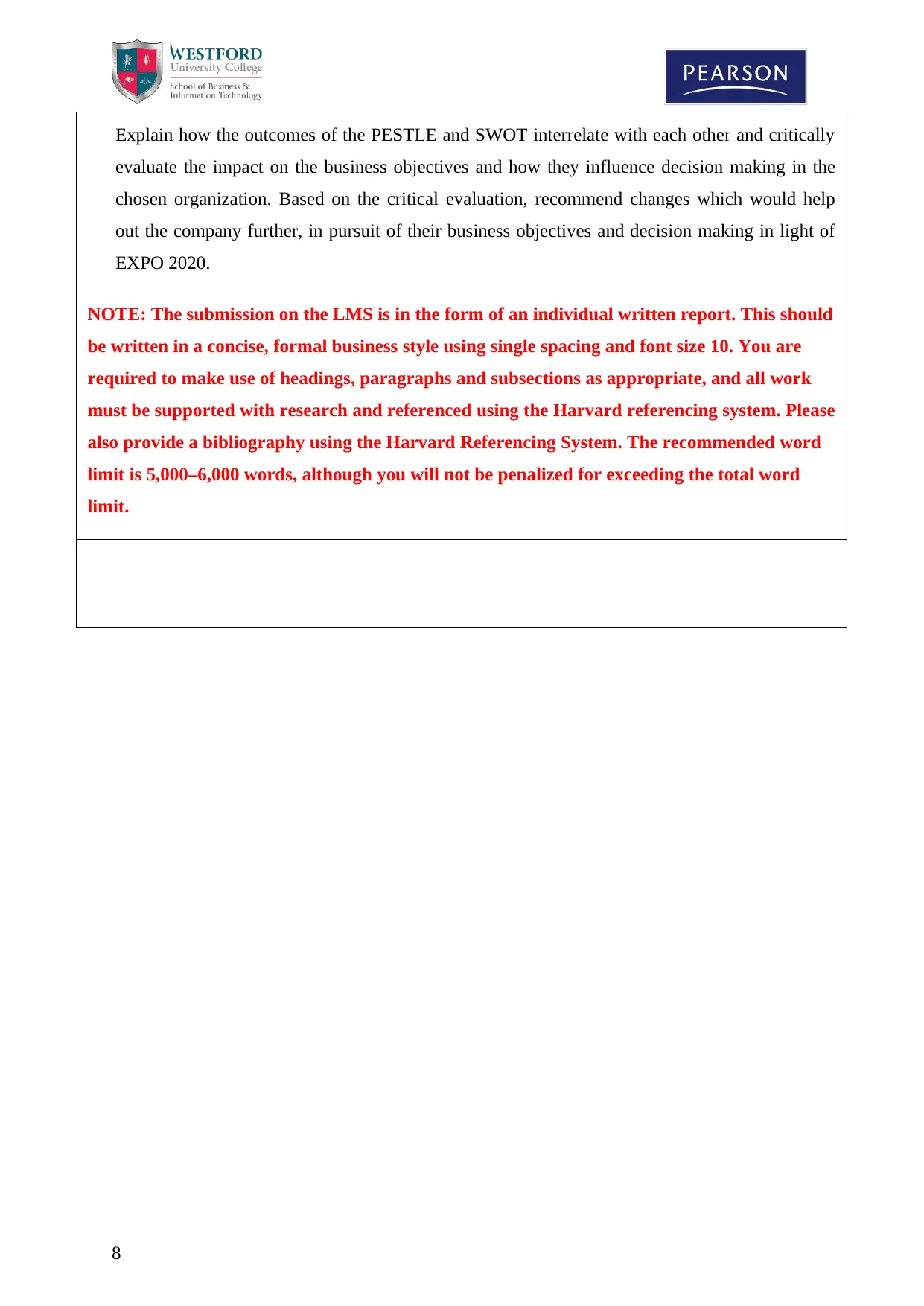
Explain how the outcomes of the PESTLE and SWOT interrelate with each other and critically
evaluate the impact on the business objectives and how they influence decision making in the
chosen organization. Based on the critical evaluation, recommend changes which would help
out the company further, in pursuit of their business objectives and decision making in light of
EXPO 2020.
NOTE: The submission on the LMS is in the form of an individual written report. This should
be written in a concise, formal business style using single spacing and font size 10. You are
required to make use of headings, paragraphs and subsections as appropriate, and all work
must be supported with research and referenced using the Harvard referencing system. Please
also provide a bibliography using the Harvard Referencing System. The recommended word
limit is 5,000–6,000 words, although you will not be penalized for exceeding the total word
limit.
8
evaluate the impact on the business objectives and how they influence decision making in the
chosen organization. Based on the critical evaluation, recommend changes which would help
out the company further, in pursuit of their business objectives and decision making in light of
EXPO 2020.
NOTE: The submission on the LMS is in the form of an individual written report. This should
be written in a concise, formal business style using single spacing and font size 10. You are
required to make use of headings, paragraphs and subsections as appropriate, and all work
must be supported with research and referenced using the Harvard referencing system. Please
also provide a bibliography using the Harvard Referencing System. The recommended word
limit is 5,000–6,000 words, although you will not be penalized for exceeding the total word
limit.
8
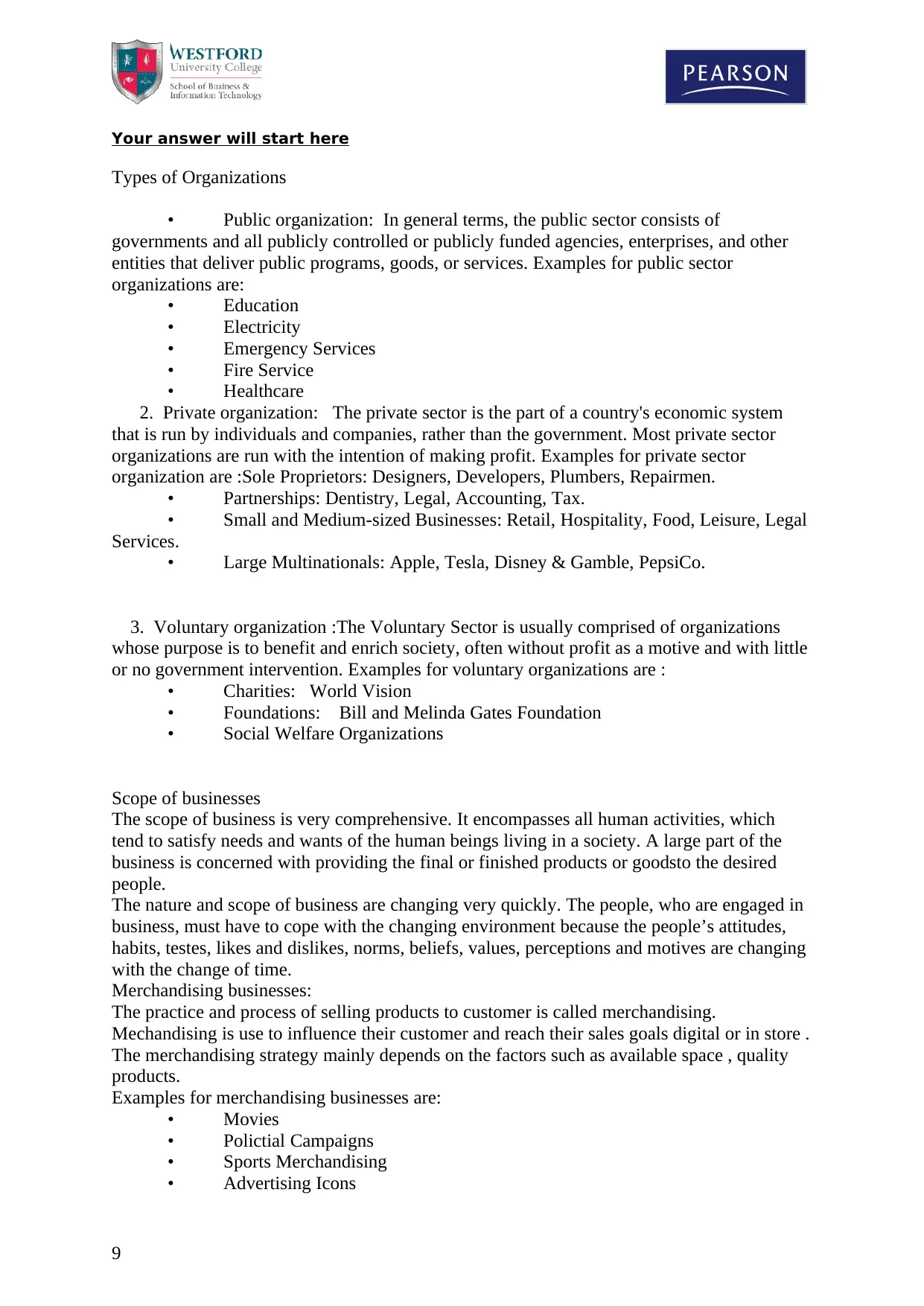
Your answer will start here
Types of Organizations
• Public organization: In general terms, the public sector consists of
governments and all publicly controlled or publicly funded agencies, enterprises, and other
entities that deliver public programs, goods, or services. Examples for public sector
organizations are:
• Education
• Electricity
• Emergency Services
• Fire Service
• Healthcare
2. Private organization: The private sector is the part of a country's economic system
that is run by individuals and companies, rather than the government. Most private sector
organizations are run with the intention of making profit. Examples for private sector
organization are :Sole Proprietors: Designers, Developers, Plumbers, Repairmen.
• Partnerships: Dentistry, Legal, Accounting, Tax.
• Small and Medium-sized Businesses: Retail, Hospitality, Food, Leisure, Legal
Services.
• Large Multinationals: Apple, Tesla, Disney & Gamble, PepsiCo.
3. Voluntary organization :The Voluntary Sector is usually comprised of organizations
whose purpose is to benefit and enrich society, often without profit as a motive and with little
or no government intervention. Examples for voluntary organizations are :
• Charities: World Vision
• Foundations: Bill and Melinda Gates Foundation
• Social Welfare Organizations
Scope of businesses
The scope of business is very comprehensive. It encompasses all human activities, which
tend to satisfy needs and wants of the human beings living in a society. A large part of the
business is concerned with providing the final or finished products or goodsto the desired
people.
The nature and scope of business are changing very quickly. The people, who are engaged in
business, must have to cope with the changing environment because the people’s attitudes,
habits, testes, likes and dislikes, norms, beliefs, values, perceptions and motives are changing
with the change of time.
Merchandising businesses:
The practice and process of selling products to customer is called merchandising.
Mechandising is use to influence their customer and reach their sales goals digital or in store .
The merchandising strategy mainly depends on the factors such as available space , quality
products.
Examples for merchandising businesses are:
• Movies
• Polictial Campaigns
• Sports Merchandising
• Advertising Icons
9
Types of Organizations
• Public organization: In general terms, the public sector consists of
governments and all publicly controlled or publicly funded agencies, enterprises, and other
entities that deliver public programs, goods, or services. Examples for public sector
organizations are:
• Education
• Electricity
• Emergency Services
• Fire Service
• Healthcare
2. Private organization: The private sector is the part of a country's economic system
that is run by individuals and companies, rather than the government. Most private sector
organizations are run with the intention of making profit. Examples for private sector
organization are :Sole Proprietors: Designers, Developers, Plumbers, Repairmen.
• Partnerships: Dentistry, Legal, Accounting, Tax.
• Small and Medium-sized Businesses: Retail, Hospitality, Food, Leisure, Legal
Services.
• Large Multinationals: Apple, Tesla, Disney & Gamble, PepsiCo.
3. Voluntary organization :The Voluntary Sector is usually comprised of organizations
whose purpose is to benefit and enrich society, often without profit as a motive and with little
or no government intervention. Examples for voluntary organizations are :
• Charities: World Vision
• Foundations: Bill and Melinda Gates Foundation
• Social Welfare Organizations
Scope of businesses
The scope of business is very comprehensive. It encompasses all human activities, which
tend to satisfy needs and wants of the human beings living in a society. A large part of the
business is concerned with providing the final or finished products or goodsto the desired
people.
The nature and scope of business are changing very quickly. The people, who are engaged in
business, must have to cope with the changing environment because the people’s attitudes,
habits, testes, likes and dislikes, norms, beliefs, values, perceptions and motives are changing
with the change of time.
Merchandising businesses:
The practice and process of selling products to customer is called merchandising.
Mechandising is use to influence their customer and reach their sales goals digital or in store .
The merchandising strategy mainly depends on the factors such as available space , quality
products.
Examples for merchandising businesses are:
• Movies
• Polictial Campaigns
• Sports Merchandising
• Advertising Icons
9
⊘ This is a preview!⊘
Do you want full access?
Subscribe today to unlock all pages.

Trusted by 1+ million students worldwide
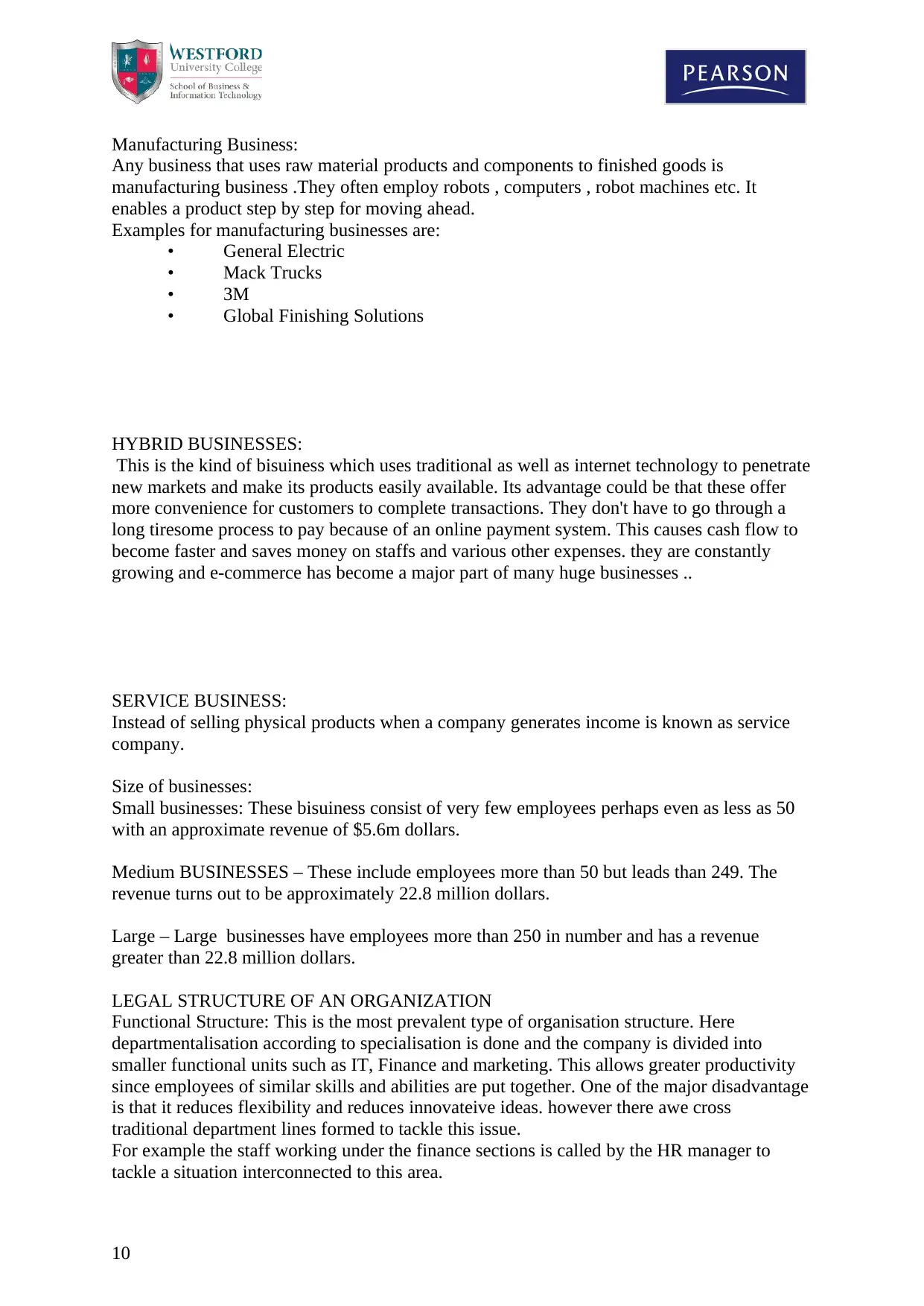
Manufacturing Business:
Any business that uses raw material products and components to finished goods is
manufacturing business .They often employ robots , computers , robot machines etc. It
enables a product step by step for moving ahead.
Examples for manufacturing businesses are:
• General Electric
• Mack Trucks
• 3M
• Global Finishing Solutions
HYBRID BUSINESSES:
This is the kind of bisuiness which uses traditional as well as internet technology to penetrate
new markets and make its products easily available. Its advantage could be that these offer
more convenience for customers to complete transactions. They don't have to go through a
long tiresome process to pay because of an online payment system. This causes cash flow to
become faster and saves money on staffs and various other expenses. they are constantly
growing and e-commerce has become a major part of many huge businesses ..
SERVICE BUSINESS:
Instead of selling physical products when a company generates income is known as service
company.
Size of businesses:
Small businesses: These bisuiness consist of very few employees perhaps even as less as 50
with an approximate revenue of $5.6m dollars.
Medium BUSINESSES – These include employees more than 50 but leads than 249. The
revenue turns out to be approximately 22.8 million dollars.
Large – Large businesses have employees more than 250 in number and has a revenue
greater than 22.8 million dollars.
LEGAL STRUCTURE OF AN ORGANIZATION
Functional Structure: This is the most prevalent type of organisation structure. Here
departmentalisation according to specialisation is done and the company is divided into
smaller functional units such as IT, Finance and marketing. This allows greater productivity
since employees of similar skills and abilities are put together. One of the major disadvantage
is that it reduces flexibility and reduces innovateive ideas. however there awe cross
traditional department lines formed to tackle this issue.
For example the staff working under the finance sections is called by the HR manager to
tackle a situation interconnected to this area.
10
Any business that uses raw material products and components to finished goods is
manufacturing business .They often employ robots , computers , robot machines etc. It
enables a product step by step for moving ahead.
Examples for manufacturing businesses are:
• General Electric
• Mack Trucks
• 3M
• Global Finishing Solutions
HYBRID BUSINESSES:
This is the kind of bisuiness which uses traditional as well as internet technology to penetrate
new markets and make its products easily available. Its advantage could be that these offer
more convenience for customers to complete transactions. They don't have to go through a
long tiresome process to pay because of an online payment system. This causes cash flow to
become faster and saves money on staffs and various other expenses. they are constantly
growing and e-commerce has become a major part of many huge businesses ..
SERVICE BUSINESS:
Instead of selling physical products when a company generates income is known as service
company.
Size of businesses:
Small businesses: These bisuiness consist of very few employees perhaps even as less as 50
with an approximate revenue of $5.6m dollars.
Medium BUSINESSES – These include employees more than 50 but leads than 249. The
revenue turns out to be approximately 22.8 million dollars.
Large – Large businesses have employees more than 250 in number and has a revenue
greater than 22.8 million dollars.
LEGAL STRUCTURE OF AN ORGANIZATION
Functional Structure: This is the most prevalent type of organisation structure. Here
departmentalisation according to specialisation is done and the company is divided into
smaller functional units such as IT, Finance and marketing. This allows greater productivity
since employees of similar skills and abilities are put together. One of the major disadvantage
is that it reduces flexibility and reduces innovateive ideas. however there awe cross
traditional department lines formed to tackle this issue.
For example the staff working under the finance sections is called by the HR manager to
tackle a situation interconnected to this area.
10
Paraphrase This Document
Need a fresh take? Get an instant paraphrase of this document with our AI Paraphraser
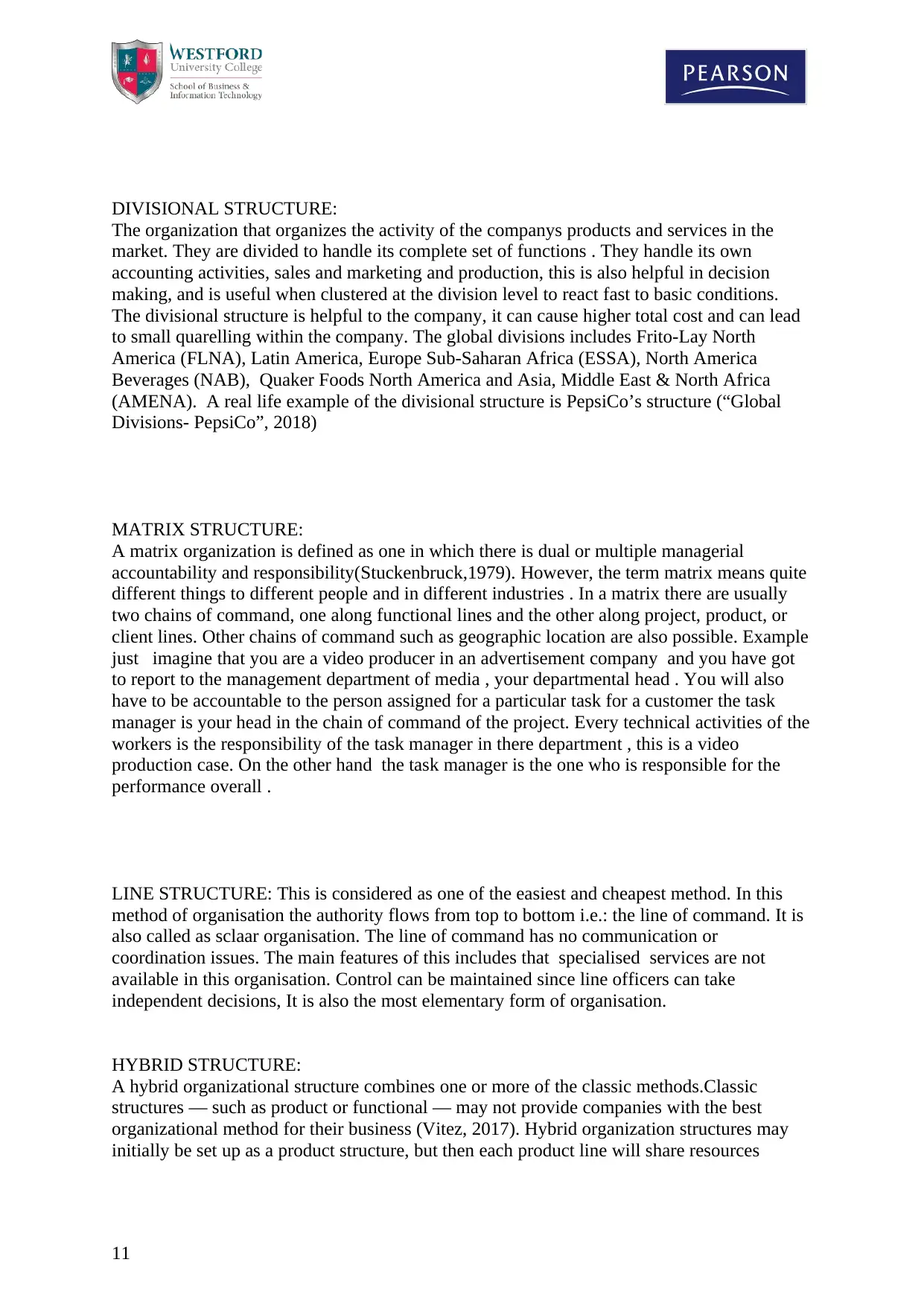
DIVISIONAL STRUCTURE:
The organization that organizes the activity of the companys products and services in the
market. They are divided to handle its complete set of functions . They handle its own
accounting activities, sales and marketing and production, this is also helpful in decision
making, and is useful when clustered at the division level to react fast to basic conditions.
The divisional structure is helpful to the company, it can cause higher total cost and can lead
to small quarelling within the company. The global divisions includes Frito-Lay North
America (FLNA), Latin America, Europe Sub-Saharan Africa (ESSA), North America
Beverages (NAB), Quaker Foods North America and Asia, Middle East & North Africa
(AMENA). A real life example of the divisional structure is PepsiCo’s structure (“Global
Divisions- PepsiCo”, 2018)
MATRIX STRUCTURE:
A matrix organization is defined as one in which there is dual or multiple managerial
accountability and responsibility(Stuckenbruck,1979). However, the term matrix means quite
different things to different people and in different industries . In a matrix there are usually
two chains of command, one along functional lines and the other along project, product, or
client lines. Other chains of command such as geographic location are also possible. Example
just imagine that you are a video producer in an advertisement company and you have got
to report to the management department of media , your departmental head . You will also
have to be accountable to the person assigned for a particular task for a customer the task
manager is your head in the chain of command of the project. Every technical activities of the
workers is the responsibility of the task manager in there department , this is a video
production case. On the other hand the task manager is the one who is responsible for the
performance overall .
LINE STRUCTURE: This is considered as one of the easiest and cheapest method. In this
method of organisation the authority flows from top to bottom i.e.: the line of command. It is
also called as sclaar organisation. The line of command has no communication or
coordination issues. The main features of this includes that specialised services are not
available in this organisation. Control can be maintained since line officers can take
independent decisions, It is also the most elementary form of organisation.
HYBRID STRUCTURE:
A hybrid organizational structure combines one or more of the classic methods.Classic
structures — such as product or functional — may not provide companies with the best
organizational method for their business (Vitez, 2017). Hybrid organization structures may
initially be set up as a product structure, but then each product line will share resources
11
The organization that organizes the activity of the companys products and services in the
market. They are divided to handle its complete set of functions . They handle its own
accounting activities, sales and marketing and production, this is also helpful in decision
making, and is useful when clustered at the division level to react fast to basic conditions.
The divisional structure is helpful to the company, it can cause higher total cost and can lead
to small quarelling within the company. The global divisions includes Frito-Lay North
America (FLNA), Latin America, Europe Sub-Saharan Africa (ESSA), North America
Beverages (NAB), Quaker Foods North America and Asia, Middle East & North Africa
(AMENA). A real life example of the divisional structure is PepsiCo’s structure (“Global
Divisions- PepsiCo”, 2018)
MATRIX STRUCTURE:
A matrix organization is defined as one in which there is dual or multiple managerial
accountability and responsibility(Stuckenbruck,1979). However, the term matrix means quite
different things to different people and in different industries . In a matrix there are usually
two chains of command, one along functional lines and the other along project, product, or
client lines. Other chains of command such as geographic location are also possible. Example
just imagine that you are a video producer in an advertisement company and you have got
to report to the management department of media , your departmental head . You will also
have to be accountable to the person assigned for a particular task for a customer the task
manager is your head in the chain of command of the project. Every technical activities of the
workers is the responsibility of the task manager in there department , this is a video
production case. On the other hand the task manager is the one who is responsible for the
performance overall .
LINE STRUCTURE: This is considered as one of the easiest and cheapest method. In this
method of organisation the authority flows from top to bottom i.e.: the line of command. It is
also called as sclaar organisation. The line of command has no communication or
coordination issues. The main features of this includes that specialised services are not
available in this organisation. Control can be maintained since line officers can take
independent decisions, It is also the most elementary form of organisation.
HYBRID STRUCTURE:
A hybrid organizational structure combines one or more of the classic methods.Classic
structures — such as product or functional — may not provide companies with the best
organizational method for their business (Vitez, 2017). Hybrid organization structures may
initially be set up as a product structure, but then each product line will share resources
11
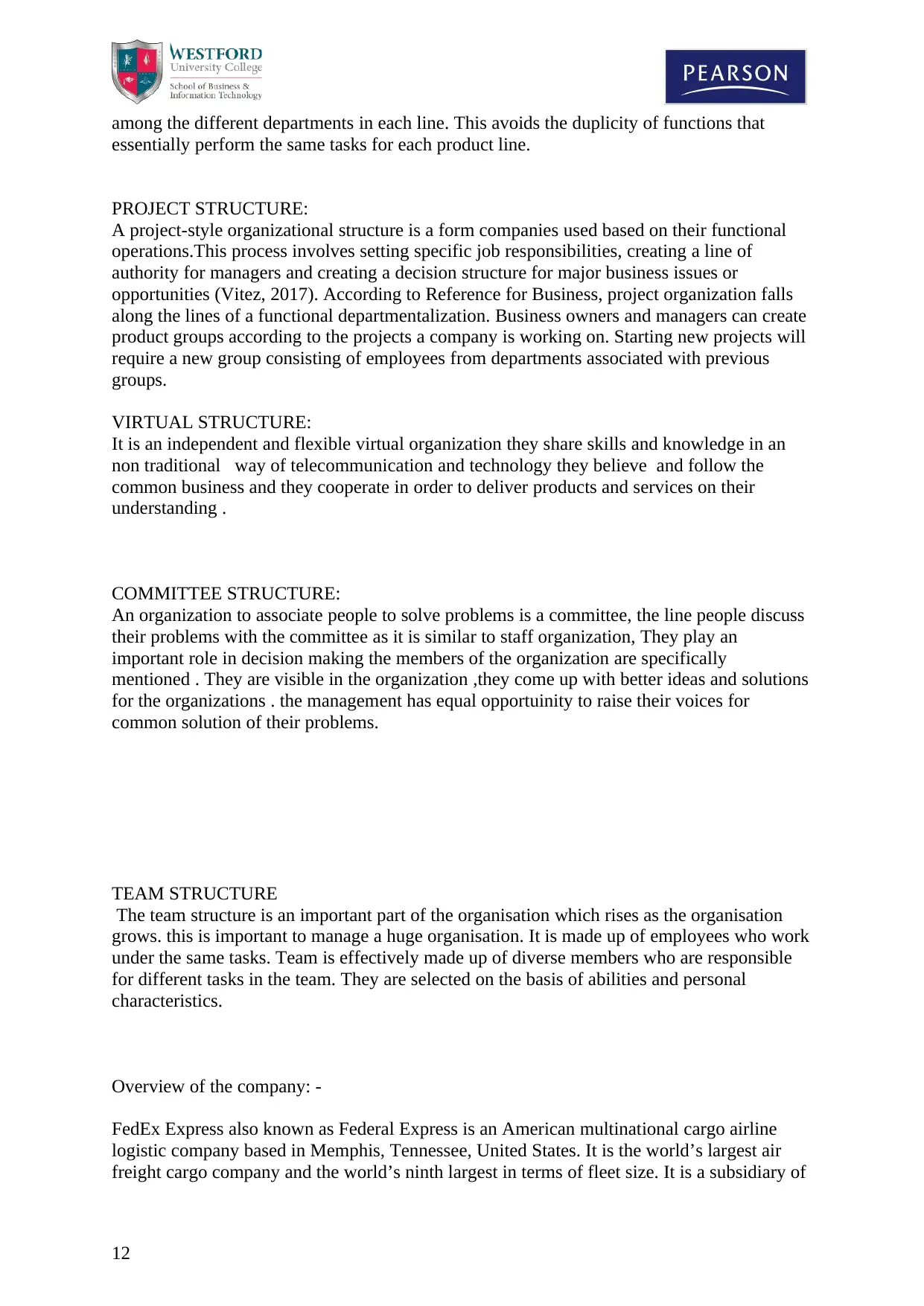
among the different departments in each line. This avoids the duplicity of functions that
essentially perform the same tasks for each product line.
PROJECT STRUCTURE:
A project-style organizational structure is a form companies used based on their functional
operations.This process involves setting specific job responsibilities, creating a line of
authority for managers and creating a decision structure for major business issues or
opportunities (Vitez, 2017). According to Reference for Business, project organization falls
along the lines of a functional departmentalization. Business owners and managers can create
product groups according to the projects a company is working on. Starting new projects will
require a new group consisting of employees from departments associated with previous
groups.
VIRTUAL STRUCTURE:
It is an independent and flexible virtual organization they share skills and knowledge in an
non traditional way of telecommunication and technology they believe and follow the
common business and they cooperate in order to deliver products and services on their
understanding .
COMMITTEE STRUCTURE:
An organization to associate people to solve problems is a committee, the line people discuss
their problems with the committee as it is similar to staff organization, They play an
important role in decision making the members of the organization are specifically
mentioned . They are visible in the organization ,they come up with better ideas and solutions
for the organizations . the management has equal opportuinity to raise their voices for
common solution of their problems.
TEAM STRUCTURE
The team structure is an important part of the organisation which rises as the organisation
grows. this is important to manage a huge organisation. It is made up of employees who work
under the same tasks. Team is effectively made up of diverse members who are responsible
for different tasks in the team. They are selected on the basis of abilities and personal
characteristics.
Overview of the company: -
FedEx Express also known as Federal Express is an American multinational cargo airline
logistic company based in Memphis, Tennessee, United States. It is the world’s largest air
freight cargo company and the world’s ninth largest in terms of fleet size. It is a subsidiary of
12
essentially perform the same tasks for each product line.
PROJECT STRUCTURE:
A project-style organizational structure is a form companies used based on their functional
operations.This process involves setting specific job responsibilities, creating a line of
authority for managers and creating a decision structure for major business issues or
opportunities (Vitez, 2017). According to Reference for Business, project organization falls
along the lines of a functional departmentalization. Business owners and managers can create
product groups according to the projects a company is working on. Starting new projects will
require a new group consisting of employees from departments associated with previous
groups.
VIRTUAL STRUCTURE:
It is an independent and flexible virtual organization they share skills and knowledge in an
non traditional way of telecommunication and technology they believe and follow the
common business and they cooperate in order to deliver products and services on their
understanding .
COMMITTEE STRUCTURE:
An organization to associate people to solve problems is a committee, the line people discuss
their problems with the committee as it is similar to staff organization, They play an
important role in decision making the members of the organization are specifically
mentioned . They are visible in the organization ,they come up with better ideas and solutions
for the organizations . the management has equal opportuinity to raise their voices for
common solution of their problems.
TEAM STRUCTURE
The team structure is an important part of the organisation which rises as the organisation
grows. this is important to manage a huge organisation. It is made up of employees who work
under the same tasks. Team is effectively made up of diverse members who are responsible
for different tasks in the team. They are selected on the basis of abilities and personal
characteristics.
Overview of the company: -
FedEx Express also known as Federal Express is an American multinational cargo airline
logistic company based in Memphis, Tennessee, United States. It is the world’s largest air
freight cargo company and the world’s ninth largest in terms of fleet size. It is a subsidiary of
12
⊘ This is a preview!⊘
Do you want full access?
Subscribe today to unlock all pages.

Trusted by 1+ million students worldwide
1 out of 19
Related Documents
Your All-in-One AI-Powered Toolkit for Academic Success.
+13062052269
info@desklib.com
Available 24*7 on WhatsApp / Email
![[object Object]](/_next/static/media/star-bottom.7253800d.svg)
Unlock your academic potential
Copyright © 2020–2025 A2Z Services. All Rights Reserved. Developed and managed by ZUCOL.





